A Survey on Nocturnal Air Conditioner Adjustment Behavior and Subjective Sleep Quality in Summer
Abstract
1. Introduction
2. Methodology
2.1. Questionnaire Design and Validation
2.2. Participants
2.3. Data Analysis
3. Results
3.1. Behaviors of Air Conditioner Usages During Summer Nighttime Sleep
3.1.1. Modes of Air Conditioners and Temperature Setting Behavior
3.1.2. Gender Differences in Air Conditioning Usage Behavior
3.1.3. Age Differences in Air Conditioning Usage Behavior
3.2. Subjective Sleeping Concerns During Summer Nighttime Sleep
3.2.1. Subjective Sleep Concerns Under Different Air Conditioning Modes
3.2.2. Actual Sleep Disturbances Under Different Air Condition Modes
3.2.3. Gender and Age Differences in Subjective Sleep Concerns
3.2.4. Age and Gender Difference in Actual Sleep Disturbances
3.3. Dynamic Temperature Needs During Summer Nighttime Sleep
4. Discussion
4.1. Sleep Mode and Dynamic Temperature Adjustment
4.2. Timing Mode and Subjective Sleep Quality
4.3. Air Conditioning Modes and Gender, Age Differences
4.4. Limitations and Future Remarks
5. Conclusions
Author Contributions
Funding
Institutional Review Board Statement
Informed Consent Statement
Data Availability Statement
Acknowledgments
Conflicts of Interest
References
- Ren, Z.; Mao, X.; Zhang, Z.; Wang, W. The impact of sleep deprivation on cognitive function in healthy adults: Insights from auditory P300 and reaction time analysis. Front. Neurosci. 2025, 19, 1559969. [Google Scholar] [CrossRef]
- Simon, K.C.; Nadel, L.; Payne, J.D. The functions of sleep: A cognitive neuroscience perspective. Proc. Natl. Acad. Sci. USA 2022, 119, e2201795119. [Google Scholar]
- Chinese Sleep Research Association. 2024 Chinese National Health Sleep White Paper; Chinese Sleep Research Association: Beijing, China, 2024. (In Chinese) [Google Scholar]
- Liang, S.; Chen, L.; Zhu, H.; Tian, X.; Yu, H. Respiratory immunity responses and nocturnal sleeping quality alterations under thermoneutral environments: Does the siesta matter? Indoor Built Environ. 2024, 33, 521–533. [Google Scholar] [CrossRef]
- Xu, X.; Li, S.; Yang, Y.; Lian, Z. Effects of thermal environment on body temperature rhythm and thermal sensation before and after getting into bed: A laboratory study in Shanghai, China. Energy Build. 2023, 301, 113748. [Google Scholar] [CrossRef]
- Zhu, H.; Su, H.; Yu, C. Cognitive performance in a warming planet. Indoor Built Environ. 2022, 31, 2195–2198. [Google Scholar] [CrossRef]
- Du, C.; Lin, X.; Yan, K.; Liu, H.; Yu, W.; Zhang, Y.; Li, B. A model developed for predicting thermal comfort during sleep in response to appropriate air velocity in warm environments. Build. Environ. 2022, 223, 109478. [Google Scholar] [CrossRef]
- Li, J.; Yang, L.; Long, H. Climatic impacts on energy consumption: Intensive and extensive margins. Energy Econ. 2018, 71, 332–343. [Google Scholar] [CrossRef]
- Davis, L.W.; Gertler, P.J. Contribution of air conditioning adoption to future energy use under global warming. Proc. Natl. Acad. Sci. USA 2015, 112, 5962–5967. [Google Scholar] [CrossRef]
- Wang, M.; Li, Q.; Wang, F.; Yuan, Z.; Wang, L.; Zhou, X. Residential indoor thermal environment investigation and analysis on energy saving of air conditioning in hot summer and warm winter zone in China. Urban Clim. 2023, 47, 101369. [Google Scholar] [CrossRef]
- Candas, V.; Libert, J.P.; Muzet, A. Heating and cooling stimulations during SWS and REM sleep in man. J. Therm. Biol. 1982, 7, 155–158. [Google Scholar] [CrossRef]
- Cao, T.; Lian, Z.; Zhu, J.; Xu, X.; Du, H.; Zhao, Q. Parametric study on the sleep thermal environment. Build. Simul. 2022, 15, 885–898. [Google Scholar] [CrossRef]
- Lan, L.; Pan, L.; Lian, Z.; Huang, H.; Lin, Y. Experimental study on thermal comfort of sleeping people at different air temperatures. Build. Environ. 2014, 73, 24–31. [Google Scholar] [CrossRef]
- Xu, X.; Lian, Z.; Shen, J.; Lan, L.; Sun, Y. Environmental factors affecting sleep quality in summer: A field study in Shanghai, China. J. Therm. Biol. 2021, 99, 102977. [Google Scholar] [CrossRef] [PubMed]
- Zhu, Y.; Ouyang, Q.; Cao, B.; Zhou, X.; Yu, J. Dynamic thermal environment and thermal comfort. Indoor Air 2016, 26, 125–137. [Google Scholar] [CrossRef] [PubMed]
- Tsang, T.-W.; Mui, K.-W.; Cheung, K.-H.; Wong, L.-T. An Energy-Efficient Approach for Thermal Comfort and Sleep Quality in Subtropical Bedrooms. Sustainability 2025, 17, 2432. [Google Scholar] [CrossRef]
- Lan, L.; Lian, Z.W.; Lin, Y.B. Comfortably cool bedroom environment during the initial phase of the sleeping period delays the onset of sleep in summer. Build. Environ. 2016, 103, 36–43. [Google Scholar] [CrossRef]
- Togo, F.; Aizawa, S.; Arai, J.I.; Yoshikawa, S.; Ishiwata, T.; Shephard, R.J.; Aoyagi, Y. Influence on human sleep patterns of lowering and delaying the minimum core body temperature by slow changes in the thermal environment. Sleep 2007, 30, 797–802. [Google Scholar] [CrossRef]
- Wang, M. Research on Health-Oriented Intelligent Air Conditioning Design. Master’s Thesis, Jiangnan University, Wuxi, China, 2016. (In Chinese). [Google Scholar]
- Lin, Z.; Deng, S. A questionnaire survey on sleeping thermal environment and bedroom air conditioning in high-rise residences in Hong Kong. Energy Build. 2006, 38, 1302–1307. [Google Scholar] [CrossRef]
- Sample Size Calculator. Available online: https://www.calculator.net/sample-size-calculator.html (accessed on 11 September 2025).
- Althubaiti, A. Sample size determination: A practical guide for health researchers. J. Gen. Fam. Med. 2023, 24, 72–78. [Google Scholar] [CrossRef]
- Hasan, M.K.H.; Kumar, L.K. Determining adequate sample size for social survey research: Sample size for social survey research. J. Bangladesh Agric. Univ. 2024, 22, 146–157. [Google Scholar] [CrossRef]
- Alosta, M.R.; Oweidat, I.; Alsadi, M.; Alsaraireh, M.M.; Oleimat, B.; Othman, E.H. Predictors and disturbances of sleep quality between men and women: Results from a cross-sectional study in Jordan. BMC Psychiatry 2024, 24, 200. [Google Scholar] [CrossRef]
- Say, Y.H.; Nordin, M.S.; Ng, A.L.O. Association of chronotype and sleep behaviors with mental well-being, eating behaviors, and adiposity traits: A cross-sectional study among a sample of urban Malaysian adults. BMC Public Health 2025, 25, 1168. [Google Scholar]
- Hu, L.Y.; He, Y.; Irimata, K.E.; Beresovsky, V. Much Ado About Survey Tables: A Comparison of Chi-Square Tests and Software to Analyze Categorical Survey Data. Am. Stat. 2025. [Google Scholar] [CrossRef]
- Li, Z.; Pellegrino, R.; Kelly, C.; Hummel, T. Olfactory training: Perspective from people who were disturbed by their smell problems. Eur. Arch. Oto-Rhino-Laryngol. 2024, 281, 6423–6430. [Google Scholar] [CrossRef] [PubMed]
- Luo, M.; Ji, W.; Cao, B.; Ouyang, Q.; Zhu, Y. Indoor climate and thermal physiological adaptation: Evidences from migrants with different cold indoor exposures. Build. Environ. 2016, 98, 30–38. [Google Scholar] [CrossRef]
- Xu, T.; Liu, G.; Kang, S.; Yan, T. Experimental study on human thermal comfort in dynamic thermal environment. Build. Therm. Energy Vent. Air Cond. 2010, 2, 62–66. (In Chinese) [Google Scholar]
- Ma, X.; Tong, L.; Li, Z.; Hu, S.; Zhang, Z.; Xu, Z.; Feng, H. Research on human thermal comfort under summer temperature drift environment. J. Qingdao Technol. Univ. 2024, 45, 133–139. (In Chinese) [Google Scholar]
- Jin, Y. Exploration of human thermal health in dynamic thermal environment. J. Nat. Sci. Heilongjiang Univ. 2003, 3, 89–92. (In Chinese) [Google Scholar]
- Liao, J. Research on Human Thermal Comfort in Dynamic Environment with Sudden Temperature Changes. Ph.D. Thesis, Chongqing University, Chongqing, China, 2013. (In Chinese). [Google Scholar]
- Pan, L.; Lian, Z.; Lan, L. Investigation of gender differences in sleeping comfort at different environmental temperatures. Indoor Built Environ. 2012, 21, 811–820. [Google Scholar] [CrossRef]
- Irshad, K.; Algarni, S.; Jamil, B.; Ahmad, M.T.; Khan, M.A. Effect of gender difference on sleeping comfort and building energy utilization: Field study on test chamber with thermoelectric air-cooling system. Build. Environ. 2019, 152, 214–227. [Google Scholar] [CrossRef]
- Salata, F.; Golasi, I.; Petitti, D.; de Lieto Vollaro, E.; Coppi, M.; de Lieto Vollaro, A. Relating microclimate, human thermal comfort and health during heat waves: An analysis of heat island mitigation strategies through a case study in an urban outdoor environment. Sustain. Cities Soc. 2017, 30, 79–96. [Google Scholar] [CrossRef]
- Forcada, N.; Gangolells, M.; Casals, M.; Tejedor, B.; Macarulla, M.; Gaspar, K. Field study on thermal comfort in nursing homes in heated environments. Energy Build. 2021, 244, 111032. [Google Scholar] [CrossRef]
- Zhang, H.; Chen, Y.; Rui, J.; Yoshino, H.; Zhang, J.; Chen, X.; Liu, J. Effects of thermal environment on elderly in urban and rural houses during heating season in a severe cold region of China. Energy Build. 2019, 198, 61–74. [Google Scholar] [CrossRef]
- Schellen, L.; van Marken Lichtenbelt, W.D.; Loomans, M.G.; Toftum, J.; De Wit, M.H. Differences between young adults and elderly in thermal comfort, productivity, and thermal physiology in response to a moderate temperature drift and a steady-state condition. Indoor Air 2010, 20, 273–283. [Google Scholar] [CrossRef]
- Ohnaka, T.; Tochihara, Y.; Tsuzuki, K.; Nagai, Y.; Tokuda, T.; Kawashima, Y. Preferred temperature of the elderly after cold and heat exposures determined by individual self-selection of air temperature. J. Therm. Biol. 1993, 18, 349–353. [Google Scholar] [CrossRef]
- Verma, P.; Dubey, R.; Rani, S.; Malik, S. Sleep difference between adolescents and young adults. J. Adv. Med. Med. Res. 2021, 32, 352–359. [Google Scholar] [CrossRef]
- Lucini, D.; Pagani, E.; Capria, F.; Galiano, M.; Marchese, M.; Cribellati, S.; Parati, G. Age Influences on Lifestyle and Stress Perception in the Working Population. Nutrients 2023, 15, 399. [Google Scholar] [CrossRef]
- Mao, Y.; Raju, G.; Zabidi, M.A. Association Between Occupational Stress and Sleep Quality among Chinese Workers: A Cross-Sectional Study. Front. Psychiatry 2023, 14, 1204567. [Google Scholar]
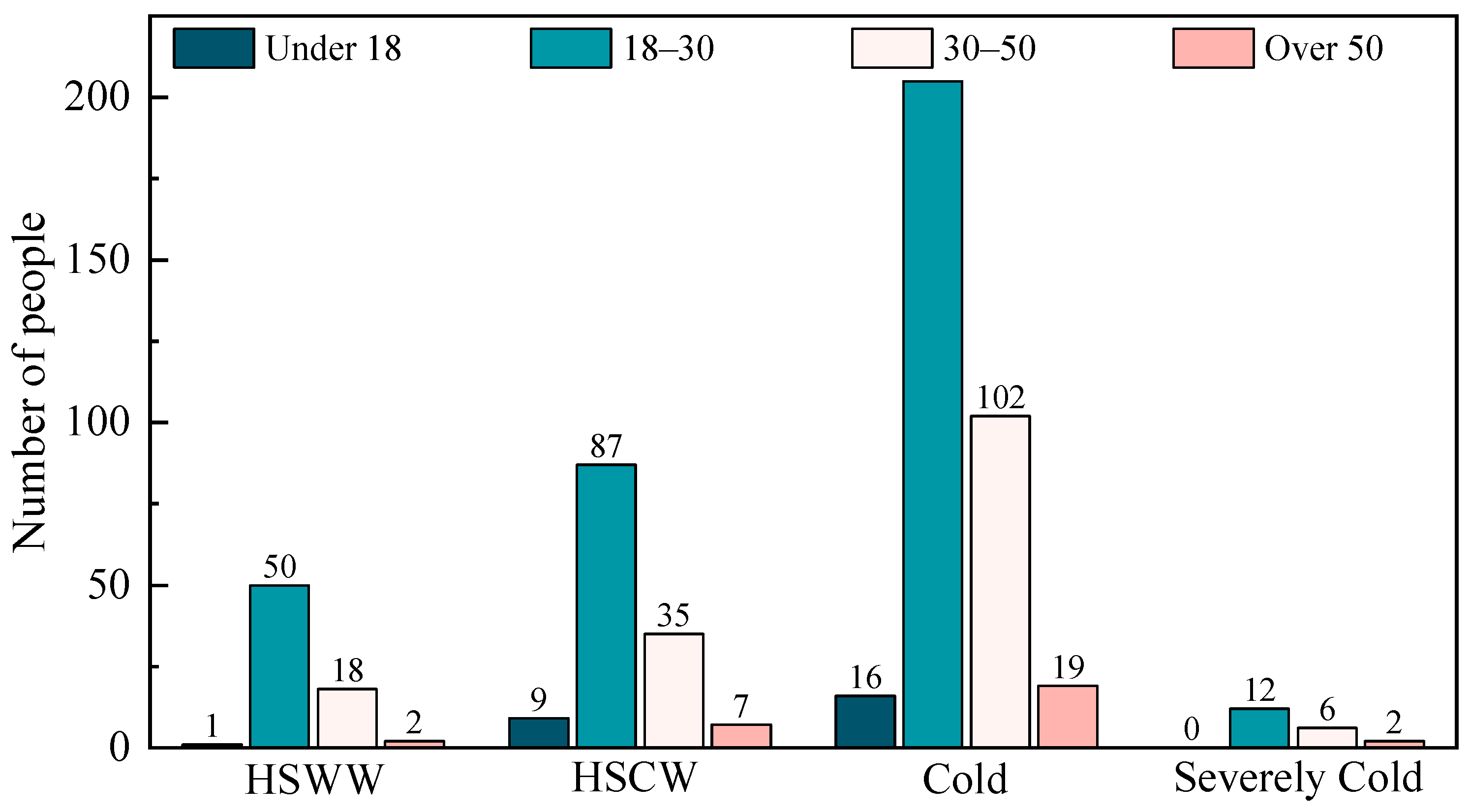
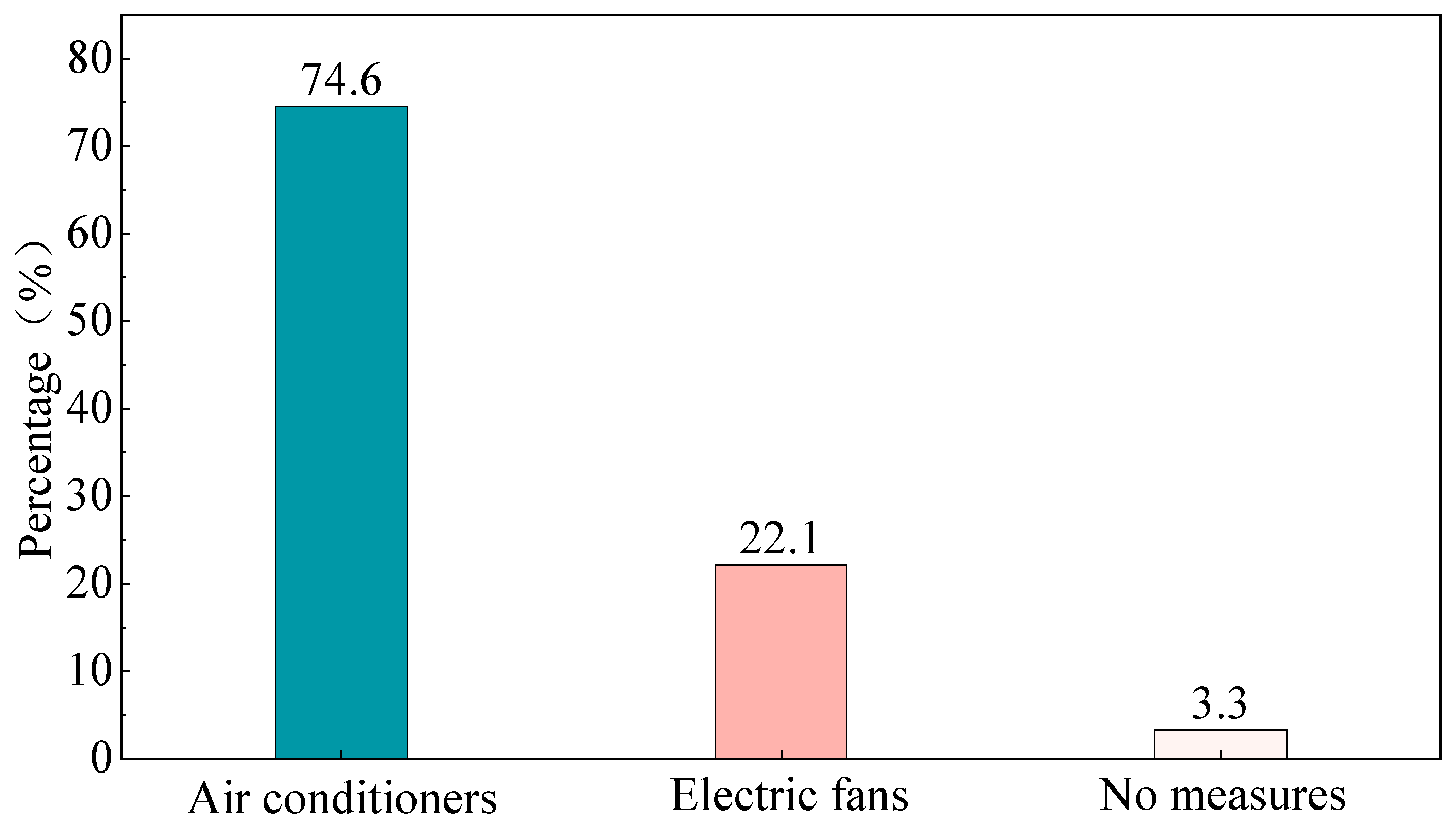
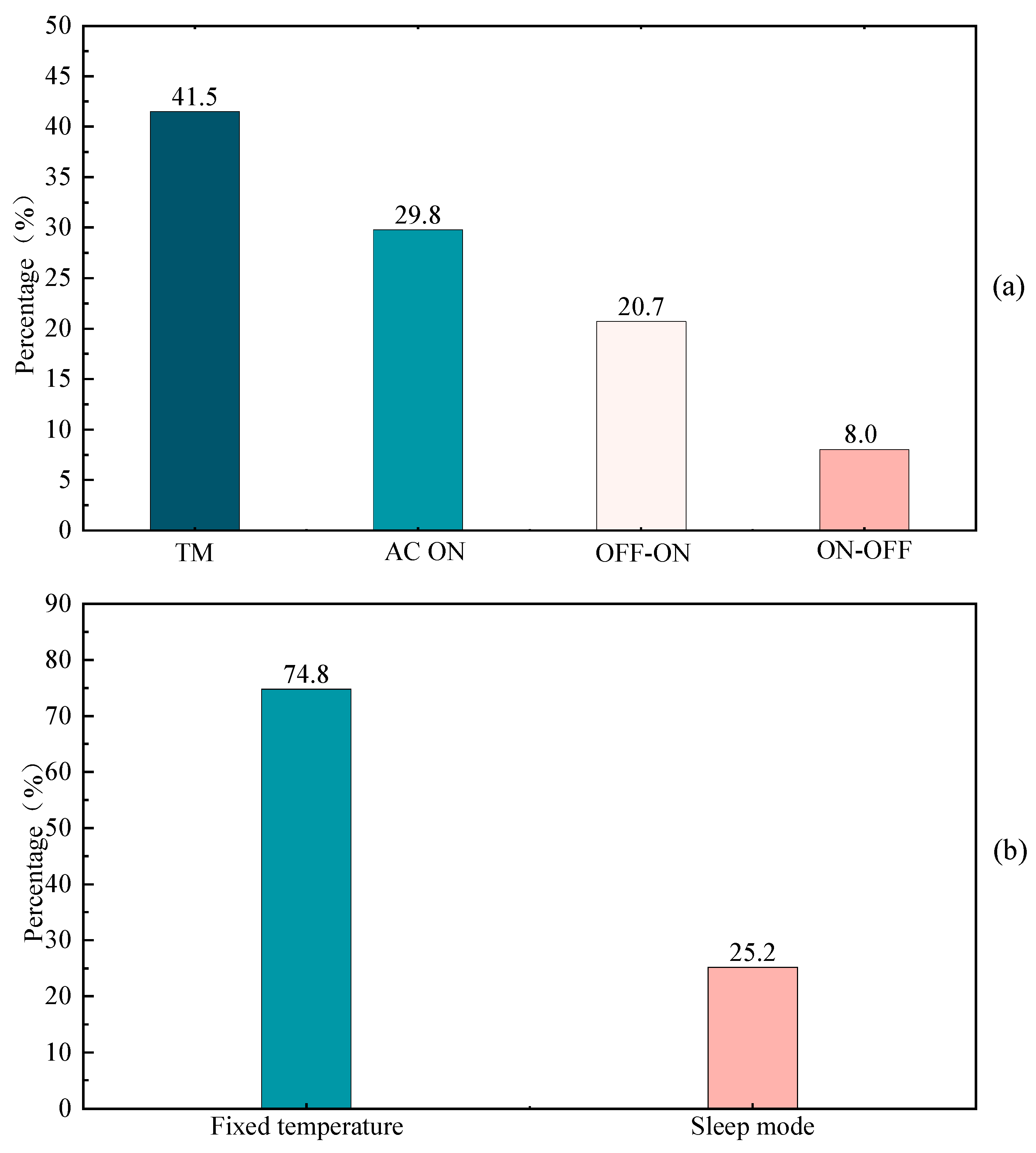
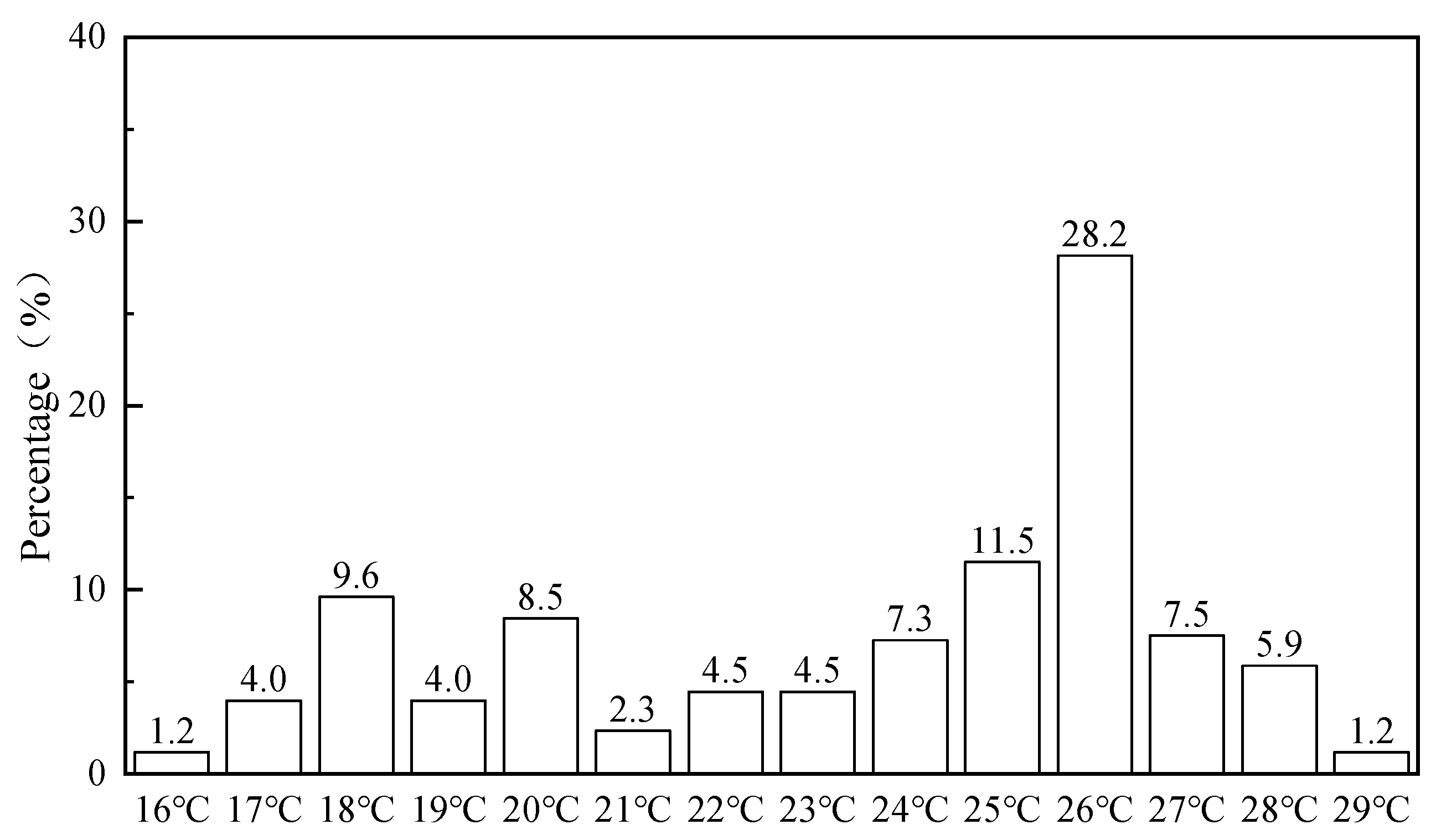

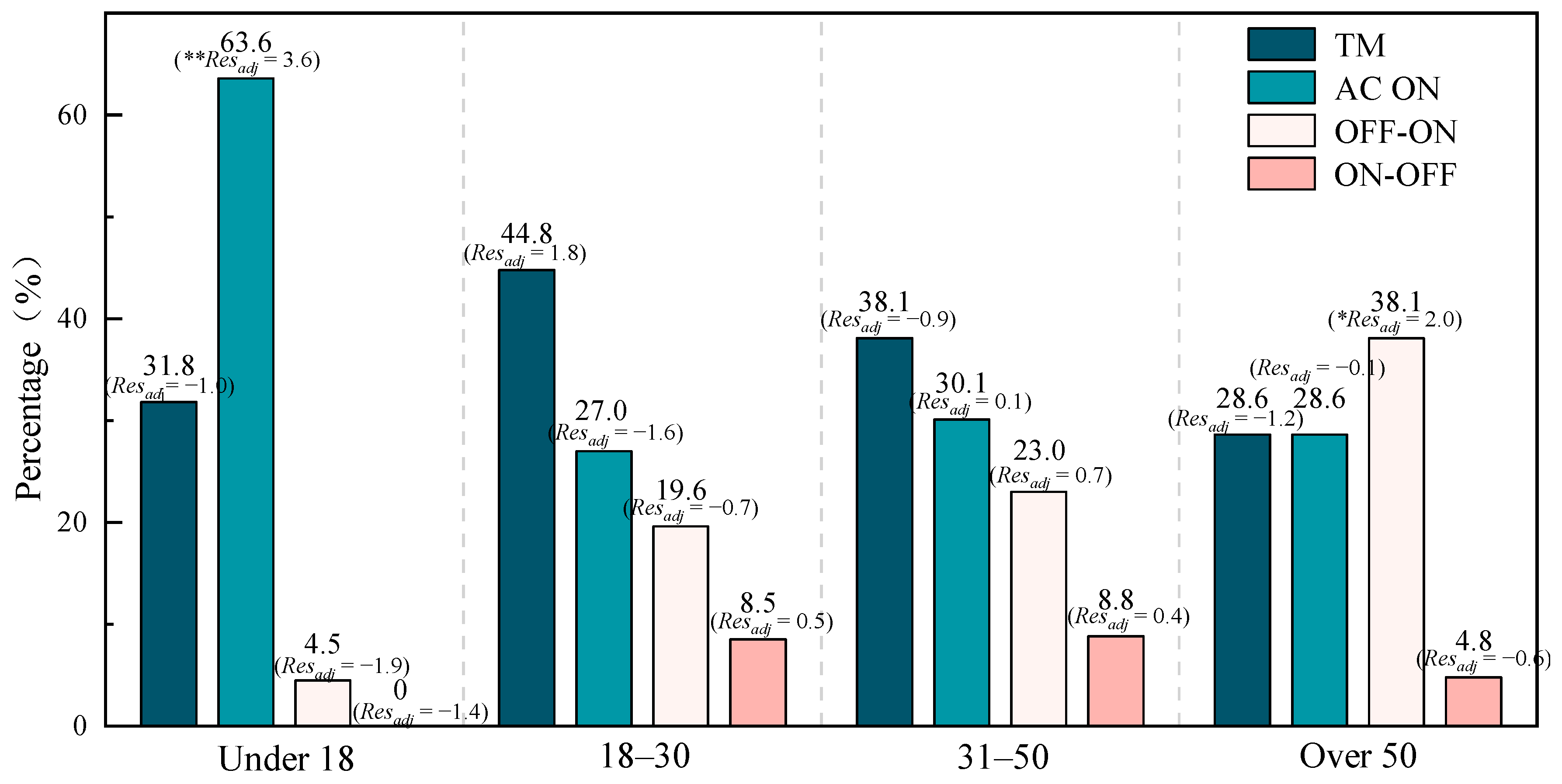
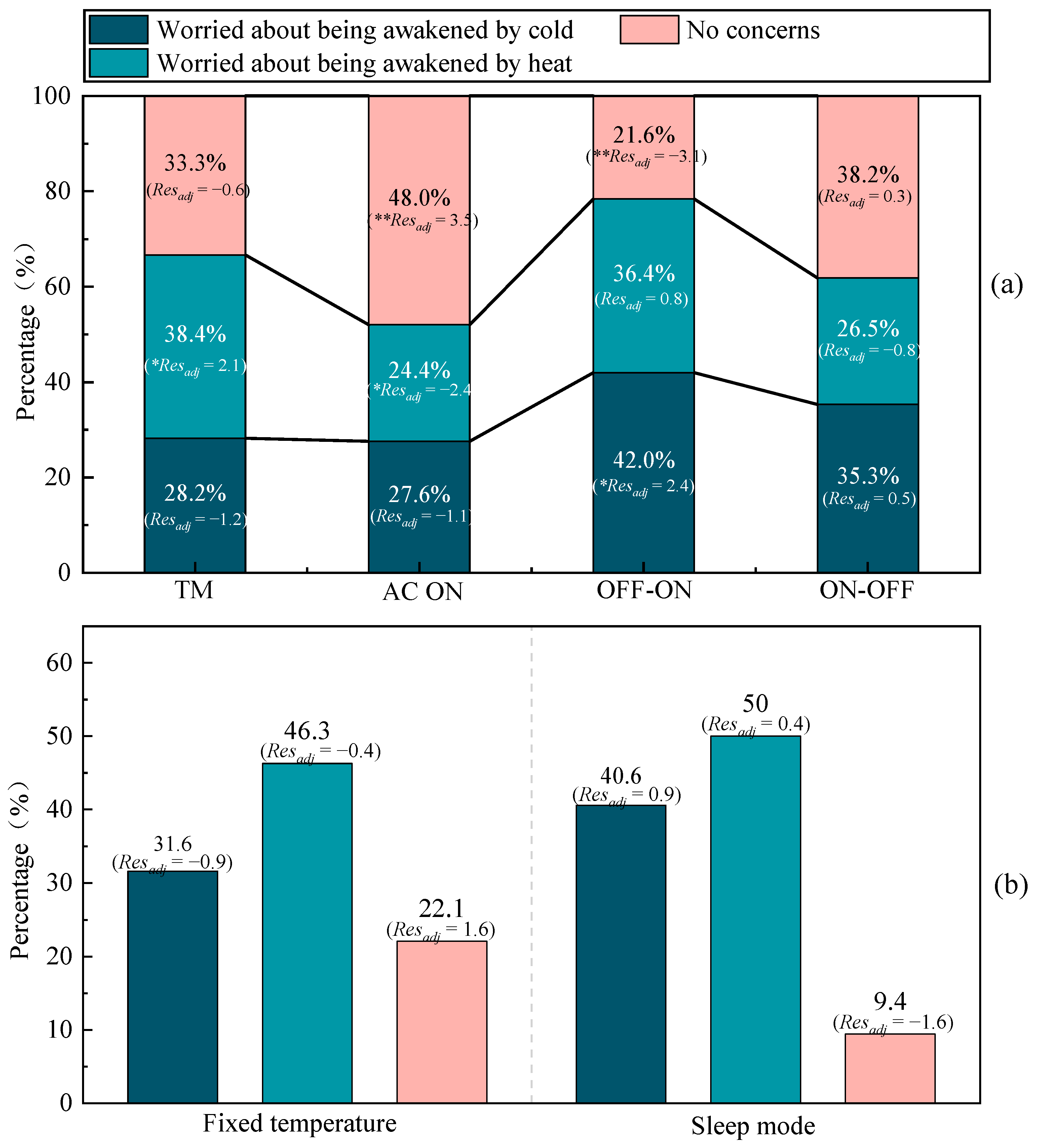
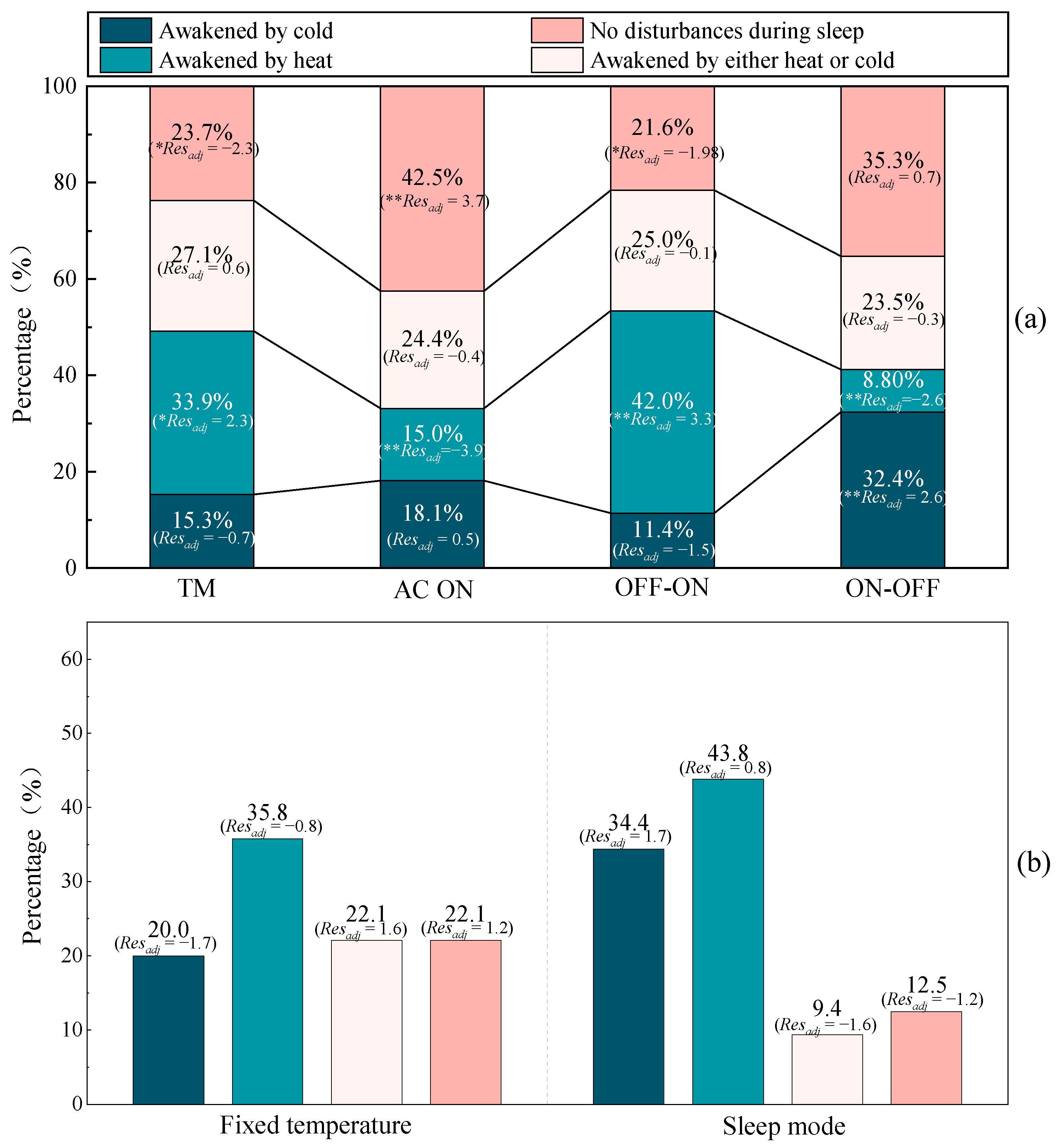
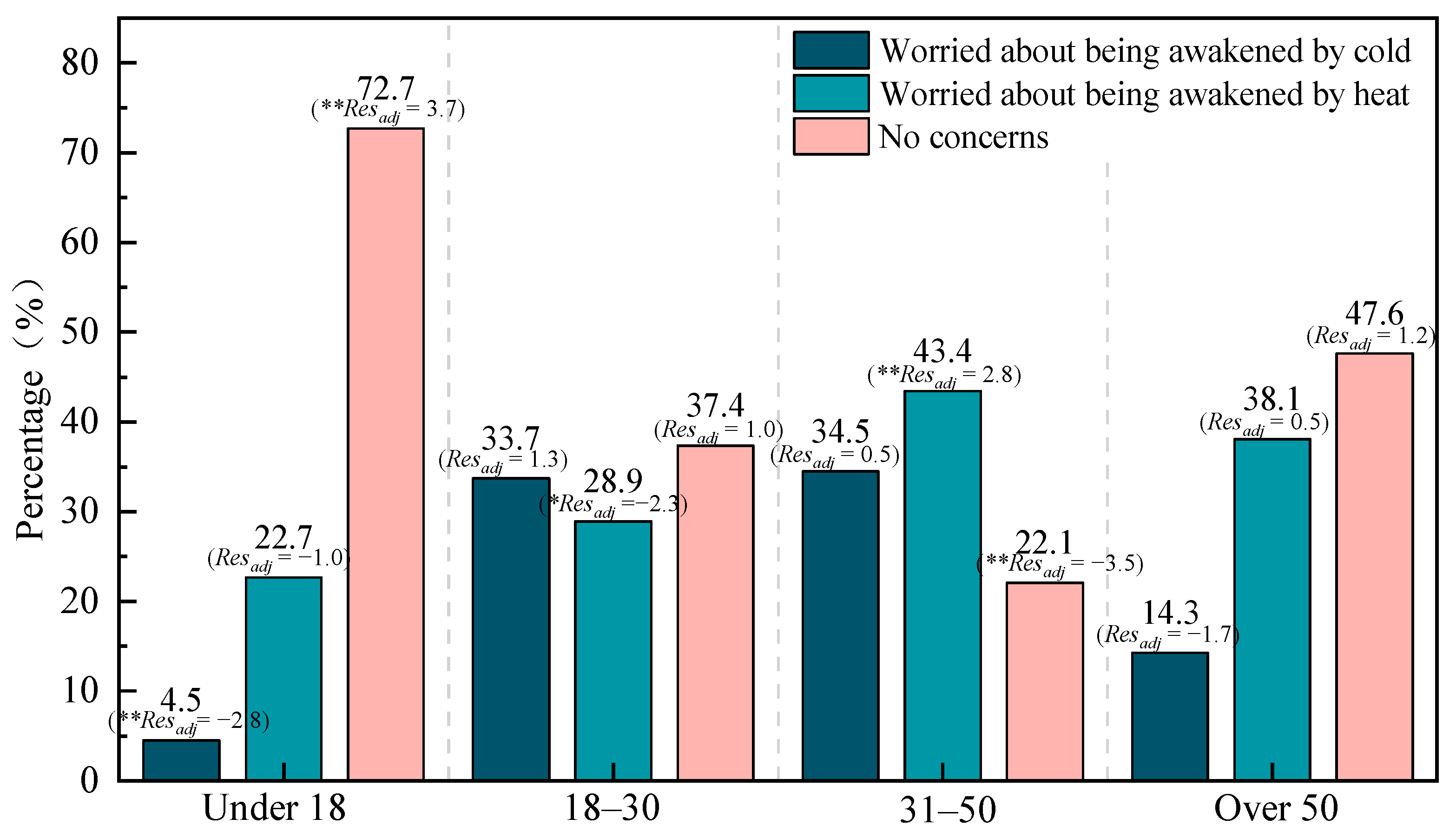
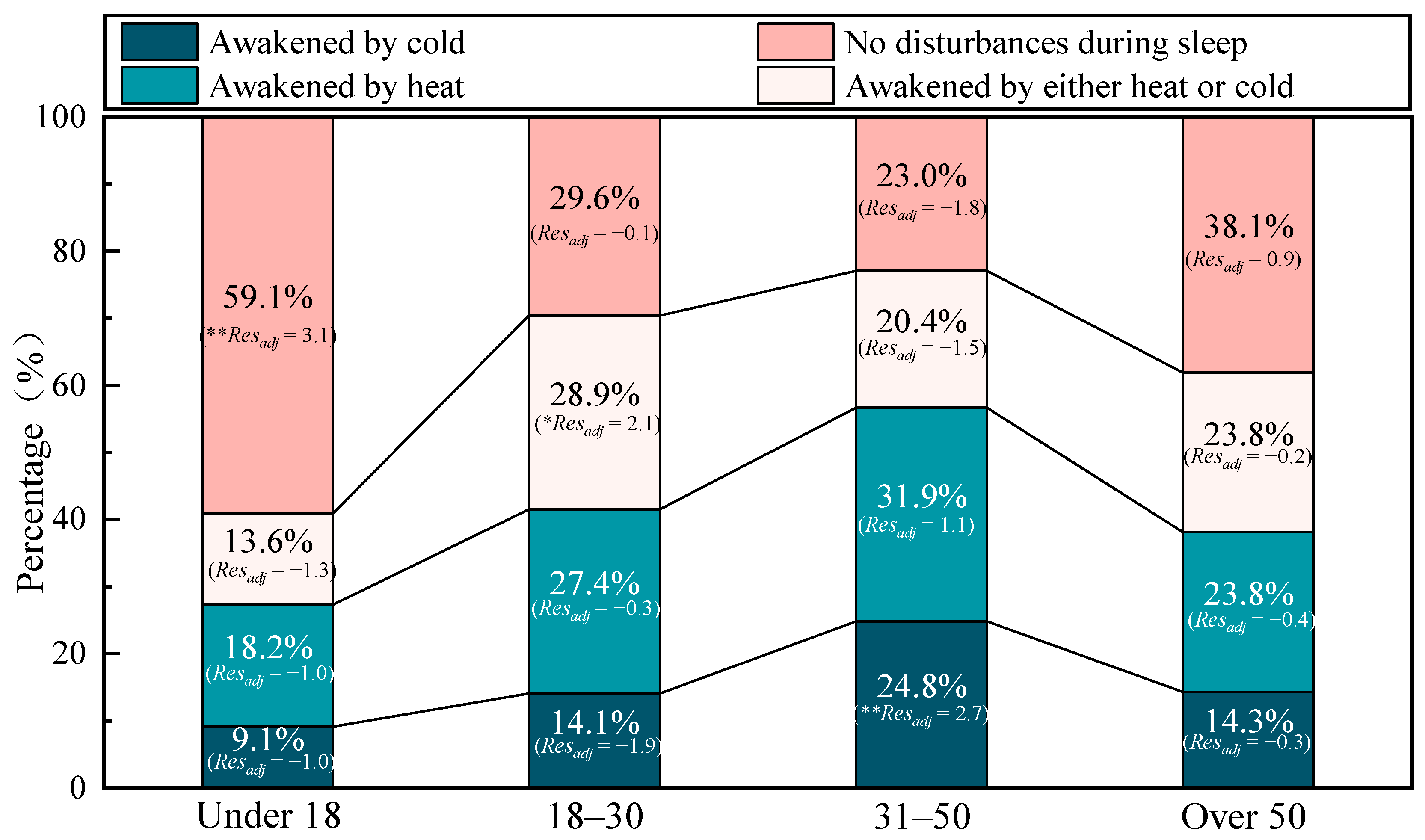

Disclaimer/Publisher’s Note: The statements, opinions and data contained in all publications are solely those of the individual author(s) and contributor(s) and not of MDPI and/or the editor(s). MDPI and/or the editor(s) disclaim responsibility for any injury to people or property resulting from any ideas, methods, instructions or products referred to in the content. |
© 2025 by the authors. Licensee MDPI, Basel, Switzerland. This article is an open access article distributed under the terms and conditions of the Creative Commons Attribution (CC BY) license (https://creativecommons.org/licenses/by/4.0/).
Share and Cite
Liang, S.; Yan, Y.; Tian, X.; Zhang, Y.; Chen, C.; Zhu, H.; Hu, S. A Survey on Nocturnal Air Conditioner Adjustment Behavior and Subjective Sleep Quality in Summer. Buildings 2025, 15, 3738. https://doi.org/10.3390/buildings15203738
Liang S, Yan Y, Tian X, Zhang Y, Chen C, Zhu H, Hu S. A Survey on Nocturnal Air Conditioner Adjustment Behavior and Subjective Sleep Quality in Summer. Buildings. 2025; 15(20):3738. https://doi.org/10.3390/buildings15203738
Chicago/Turabian StyleLiang, Shimin, Yueru Yan, Xiaohui Tian, Yujin Zhang, Cheng Chen, Hui Zhu, and Songtao Hu. 2025. "A Survey on Nocturnal Air Conditioner Adjustment Behavior and Subjective Sleep Quality in Summer" Buildings 15, no. 20: 3738. https://doi.org/10.3390/buildings15203738
APA StyleLiang, S., Yan, Y., Tian, X., Zhang, Y., Chen, C., Zhu, H., & Hu, S. (2025). A Survey on Nocturnal Air Conditioner Adjustment Behavior and Subjective Sleep Quality in Summer. Buildings, 15(20), 3738. https://doi.org/10.3390/buildings15203738







